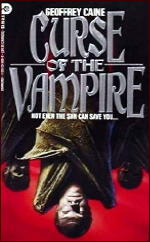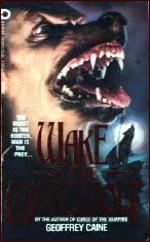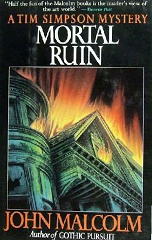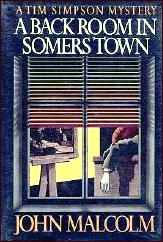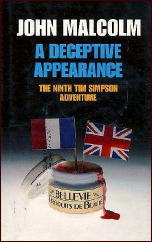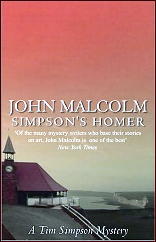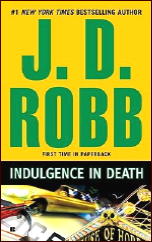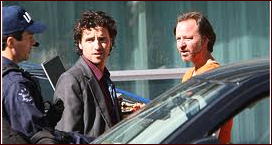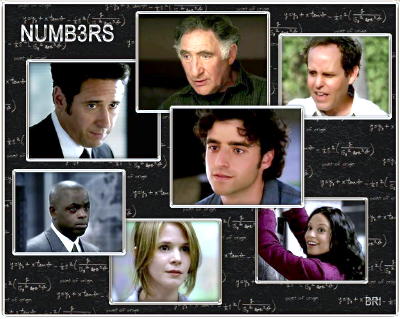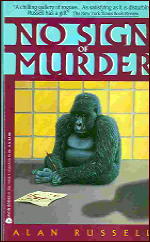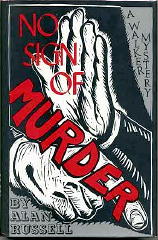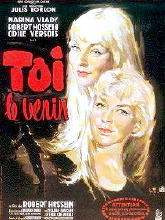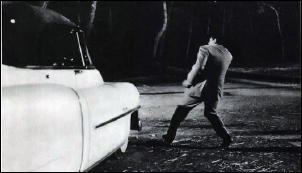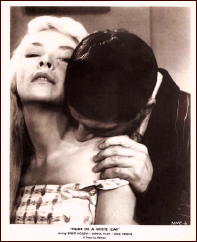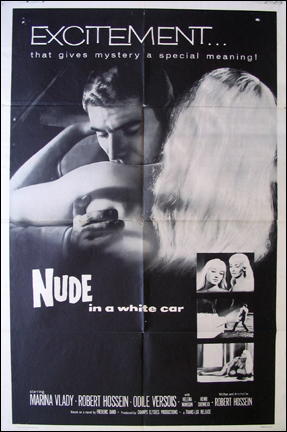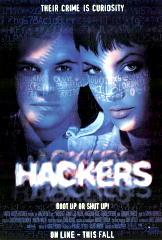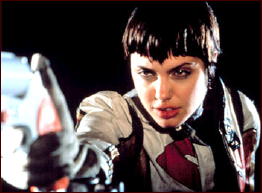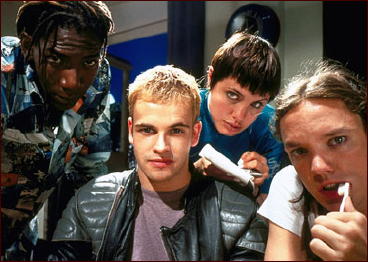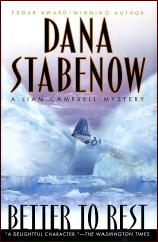Thu 5 Jul 2012
A TV Review by Michael Shonk: HARRY O in San Diego.
Posted by Steve under Reviews , TV mysteries[32] Comments
HARRY O in San Diego
September-December 1974; Thursday at 10-11pm. ABC / Warner Brothers. Cast: David Janssen as Harry Orwell, Henry Darrow as Lieutenant Manuel “Manny†Quinlan. Recurring Cast: Tom Atkins as Sgt Frank Cole, Mel Stewart as Roy Bardello. Created by Howard Rodman. Executive Producer: Jerry Thorpe. Producer: Richard E. Thompson. Associate Producer: Rita Dillon. Executive Story Consultant: Robert Dozier. Theme by Billy Goldenberg.
While the two pilots Such Dust Dreams Are Made On and Smile Jenny, You’re Dead were set in Los Angeles, the first thirteen episodes of Harry O were set and filmed in San Diego. ABC was last in the ratings and decided to try a “non-L.A. look†with some of their new shows. Seattle and Hawaii were considered, but San Diego was finally chosen (Television Chronicles #10. Thanks to Randy Cox for sending me Ed Robertson’s wonderful article.)
When we last left Harry O, we had seen the series first episode, “Gertrude†and had visions of Rockford Files dancing in our head. Those visions disappeared with the next episode “Admiral’s Lady†as Harry O quickly returned to the dark depressing dramas found in the pilots.
Where “Gertrude†was a mystery with eccentric characters and humor, what followed in the next several episodes were stories focused on damaged people with troubled souls.
The mystery mattered less than its effects on the characters. Harry’s narration was used for his introspective thoughts rather than exposition of the plot. Humor was as rare as hope in these early episodes, while it would slowly resurface over time it did not returned to the levels of the episode “Gertrude.â€
The drama was strong and thought provoking, and there were no happy endings, only people left trying to recover and make it through the day.
In the series second episode “Admiral’s Lady,†a much-honored Admiral, (Leif Erikson) refuses to believe his missing young wife (Sharon Acker) is dead and hires Harry to find her. Harry discovers a killer may be looking for her as well. This is more than just another episode about a serial killer on the loose. It is a story about the pain caused by love and betrayal.
Next, “Guardian At The Gates†features brilliant architect Paul Sawyer (Barry Sullivan) who is a monster as a human being. Harry is hired to find out who wants him dead. During the case Harry falls for Sawyer’s emotionally abused daughter, Marian (Linda Evans). The story is less a mystery than an examination of a genius without humanity, the price of such genius and the suffering it causes others around him.
“Mortal Sin†is about two men’s loss of faith, one a priest and the other a killer. Father Paul Vecchio (Laurence Luckinbill) and Harry are friends and have discussed the priest’s growing doubts. So when a man confesses that he has killed and will kill again, Father Paul turns to Harry, but then refuses to break the rules of the confessional. It is up to Harry to find the killer, and the priest to find his place in the church.
“Coinage of the Realm†offers a rare appearance by Harry’s car. The car repeatedly breaks down and is used as comic relief from the darkness of the story of a dying child (Dawn Lyn) who needs her father, Don (Kenneth Mars) to donate his kidney to save her life. The problem is he is on the run from the mob and has disappeared. Two gay hitmen (David Dukes and Granville Van Dusen) are hoping Harry will lead them to Don.
In “Eyewitness,†the nurse (Rosalind Cash), who had helped Harry recover from the shooting that left a bullet in his back, needs his help. Her son has been arrested for murder. Harry returns to a primarily African-American neighborhood where he had once worked as a cop. Not much had changed with old friends still just trying to survive the day. One of those friends is now drug free hooker (Margaret Avery) trying to raise her blind teenaged brother who may be the only witness to the killing. This has a typical Harry O ending, the bad guy is stopped but the victims are left with little hope of life getting better.
In “Shadows At Noon,†Harry comes home to find a woman named Marilyn (Diana Ewing) hiding in his small beach house. She has escaped from a mental hospital but claims to be as sane as he is. Mystery plays a minor role in this psychological drama about what is sanity. Harry poses as a patient in the mental hospital to find out if the girl is telling the truth. When he is betrayed and trapped there, Harry fights to keep his own sanity. The bad guys are caught in almost a dramatic afterthought as the story focused on the terrible cost to the girl and to Harry.

In “Ballinger’s Choice,†Margaret (Juliet Mills) hires Harry to find Paul, her cheating husband (Paul Burke). Harry shifts through all the lies from everyone and uncovers a disturbing twist and then murder. The mystery plays a more typical role in the plot of this morality play.
“Second Sight†has another damaged broken person enter Harry’s life. After an automobile accident turned Fay Conners (Stefanie Powers) into a blind psychic, she wrote three mysteries where the details of the crimes would later come true. She had warned a Doctor he was going to be killed. The doctor turned to Harry to be his bodyguard and Harry said no. When the doctor is killed, Harry feels guilty and tries to find who killed the Doctor and why. This is Harry O, so “why” is more important than “who.” Harry’s humor is beginning to surface again.
“Material Witness†begins when Dr. Noelle Kira (Barbara Anderson) sees mobster Joe Kiley kill a man. But witnesses against Kiley have a habit of dying or refusing to testify. Captain Jaklin (James Olson) is convinced someone in the department is tipping off Kiley about where the witnesses are being kept. He asks Harry to be the Doctor’s bodyguard for 24 hours until he can get men he trusts in place. The series is beginning to shift to more typical TV crime stories. This episode has some interesting twists and a more typical TV PI show ending.
“Forty Reasons To Kill – Part One†begins with a friend of Harry and a Harvard graduate lawyer turn Hippie, George found dead with cocaine on his body. The cops think it is a drug deal gone wrong. Harry’s search for the truth takes him to small Vardero County where he meets rich spoiled Glenna (Joanna Pettet) who becomes his lover. She had sold George 40,000 acres of land. It was a tiny piece of what she owns but it upset her over protective “uncles†(Broderick Crawford and Craig Stevens) who control the land trust and source of Glenna’s wealth. Harry is beaten up, bribed, and then framed for the murder.
“Forty Reasons To Kill – Part Two†has Manny arriving to help Harry. The audience knows something Harry doesn’t, who is behind it all. Glenna pays his bail and Harry is out and quickly learns what is behind the plot and murder. Now Harry has to stay alive long enough to prove it. The episode suffers from too much padding for a story that would have worked better as a single episode.
“Account Balanced†was the last episode shot in San Diego. An ex-girl friend (Linda Marsh) comes to Harry to find out if her husband (Robert Reed) is cheating. Harry is unhappy when he discovers the husband with another woman. But when that woman is found dead the next day of an apparent suicide, Harry realizes the husband’s secrets may be even more serious. It also featured some funny character byplay between Harry, Manny, and Manny’s less than bright assistant Sgt Cole (likably played by Tom Atkins).
Harry Orwell is a romantic seeking true justice with all wrongs corrected and the guilty punished. The resulting disappointments caused by reality has left Harry a weary grumpy man with a sardonic sense of humor.
He is honest and blunt to the point of rudeness. Harry is introspective and private, content to be alone with his thoughts. Harry admits that he hates to talk about himself or his past. Once a client caught him alone singing and playing his banjo and he reacted shyly as if she had discover a hidden secret of his.
He has little interest in material things or wealth. He may have wine but no wine glasses when paper cups will do. He dislikes mystery fiction and guns, and enjoys fishing and running on the beach alone. Little is known about his past beyond an ex-wife and that he was a Lieutenant on the San Diego Police force and has some experience in the homicide department.
Harry’s primary motivation to get involved is not money but a sense of responsibility, duty, and/or guilt. In “Material Witness,†when the Captain asks him to protect the witness, Harry asked if this was a paying job or a favor to the department. The Captain wondered what was the difference. Harry replied he could turn down a job.
Janssen is a joy to watch act. Perhaps the best example of his talents is in the jail scene from Part Two of “Forty Reasons To Kill.†Harry, who has been framed for murder, is laying face down on the cell cot when Manny enters.
Usually this is a scene that calls for anger and great emotions. Janssen plays it with an understated whimsy that was as entertaining as it was surprising. Henry Darrow followed Janssen’s lead and played his normally under control stern cop Manny with a lighter touch. Harry and Manny are friends and trust each other. This scene showed it without the need to say it.
Lieutenant Manuel “Manny†Quinlan is a career cop, and little is known beyond that. Not unlike Harry, Manny never discusses his personal life or past. He is a tough no nonsense boss to all he commands, which made dealing with independent Harry difficult for Manny.
The ratings were mediocre at best but good enough for ABC who had bigger problems with its schedule (it cancelled six shows and moved four more at midseason). Harry O was given the go ahead to shoot the rest of the first season’s episodes, but both ABC and Warners wanted changes.
The series with its slow-paced inner conflict drama and its fatalistic view of social injustice was not the action PI with car chases ABC wanted.
San Diego gave Harry O some wonderful background scenery especially the view of the ocean and city skyline from Harry’s small beach house, but the cost overruns from filming on location and the series’ ratings (not a hit like Streets of San Francisco) made Harry O’s move to Los Angeles necessary.
The Harry O episodes in San Diego (minus “Gertrudeâ€) surprised me by their darkness. The mysteries were less about who did it than the cause and effects of the crime on the characters. Every day was a struggle to survive not only from the outside forces of our lives but the inner demons those forces leave behind.
I have over thirty hours of the series left to view, so while I will be reviewing other shows these coming weeks, I will return to Harry O as soon as possible. Next in this series of reviews on Harry O I will examine how the series changed after the move to Los Angeles.
